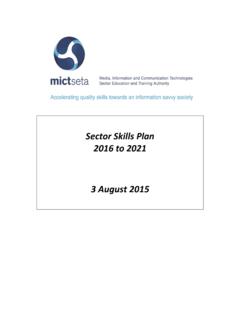Transcription of Work placements – capacity and delivery fund from …
1 Work placements capacity and delivery fund from April 2018 to July 2019 - [12/10/2017 09:20:01] HomeGuidanceWork placements capacity and delivery fund from April 2018 toJuly 2019 From:Education and Skills Funding AgencyPart of:Funding education for 16- to 19-year-olds and Further education and trainingPublished:28 September 2017 Information for post-16 institutions for work placement capacityand delivery Context Purpose Guidance documents Summary Background Principles of a substantive work placement Qualifying student Implementation plans Payments Future allocations and conditions Links to T-Levels Support for institutionsSearchWork placements capacity and delivery fund from April 2018 to July 2019 - [12/10/2017 09:20:01]ContextTwo thirds of employers rate work experience as being of significant or critical value for young entrants tothe labour market and half of employers believe a top priority for schools and colleges should bedeveloping awareness of working life with support from businesses.
2 That is why the Department forEducation (DfE) is investing in building the capacity of post 16 institutions and training providers for fulltime 16 to 18 year olds, (this funding is not available for students aged 19+) to complete a substantive workplacement for vocational and technical study programmes. We are expecting providers and employers tostart developing the capacity and capability to deliver work placements now in advance of the introductionof T levels from 2020. To this end DfE has introduced the Work Placement capacity and delivery Fund(CDF).PurposeThe CDF will be available from April 2018 to facilitate the build-up of capacity and capability to deliversubstantive work placements and deliver placements in the 2018 to 2019 academic year. The placementsare for students on vocational and technical study programmes at level 2 and level 3. It is recognised thatthe delivery of significant work placements as part of T levels will be a significant step change for thesector. This is why this funding is being provided now to help build capacity ahead of the roll out of Tlevels, from 2020, which work placements will be an essential part CDF funding is additional to the mainstream allocation, which is based on planned hours forqualifications and employability, enrichment and pastoral (EEP) hours.
3 The work placement must bedelivered on top of the usual planned hours, which must be recorded in the usual documentsThis guidance provides an overview of the requirements for funding, recording and delivering workplacements. It will be updated as more information becomes available. In addition links are provided to thefollowing supporting documentation:Work Placement capacity and delivery Fund: principles for high quality work placementsGuidance for 16 to 19 institutions completing the work placement capacity and delivery fund (CDF)implementation plan (MS Word Document, ) and progress reportsSummaryInstitutions receiving the funding need to ensure the substantive work placements being delivered meet thepublished principles so the sector is ready for large scale delivery , when T levels are rolled out. Thisincludes ensuring a work placement is:on average 50 working days in length within a range of 45 to 60 days, covering a minimum of 315 hours,(this applies to 2018 to 2019 academic year delivery only)occupationally specific and focussed on developing practical and technical skillstaking place with an external employer on a site external to the student s learning environment, (but noton another training provider s site) so that the student experiences a real life job roledelivered to a structured work planWork placements capacity and delivery fund from April 2018 to July 2019 - [12/10/2017 09:20:01]adequately supervised, andmonitored by actual site visitsFor the period up to July 2019 we will allocate the CDF based on the number of qualifying students in the2015 to 2016 academic year at a funding rate of 250 per qualifying student.
4 Institutions with low qualifyingstudents numbers will be allocated a flat rate those with 1 to 10 qualifying students will be allocated 2,500, those with 11 to 20 qualifying students will be allocated 5,000. Payments will start in September2018 for academies and in August 2018 for all other institutions/providers. However, we will expectcapacity building activity to start from April 2018 so that institutions can deliver work placements fromSeptember order to receive this funding institutions are required to opt in and agree to:utilise the funding to build capability and capacity for delivery of high quality substantive workplacementsthe delivery of high quality substantive work placements during the 2018 to 2019 academic year in linewith the principles set outdeliver at least a set number of high quality substantive work placements in 2018 to 2019 academic year- no fewer than 10% of the number of qualifying students on full time level 2 and/or level 3 vocationaland technical programmes in 2015 to 2016 academic yearprovide a completed implementation plan template to the Education and Skills Funding Agency (ESFA)
5 By 24 November 2017, that clearly outlines what the short and medium term actions will be to ensuredelivery of placements in the 2018 to 2019 academic year, and how this will help support delivery infuture once T levels have been introducedprovide termly monitoring/progress reports to the ESFA on 1 October 2018, 1 February 2019 and 1 June2019conduct student and employer satisfaction surveysrecord all high quality substantive work placements fully in the ILR or school census at each data returnpointAdditional funding through the CDF will be available in future years to support providers to deliver workplacements for T levels. The number of placements that will need to be delivered with future funding willincrease. We will specify the number of required placements before each year s allocation. Providers thatdo not meet the expectations each year should expect to receive a reduced allocation the following T levels are rolled out from 2020, all students doing a T level will be required to successfullycomplete a work placement.
6 This will be in addition to those students on other vocational courses that willnot at that point have transitioned to T levels, and who we will also expect to do work placements . We willtherefore expect institutions to keep pace with this increase in should be clear that access to the CDF in 2018 to 2019 academic year does not imply futureeligibility to deliver or receive funding for the development or delivery of T-levels. We will review ourapproach to funding work placements before each year s funding is 6 July Education Secretary Justine Greening confirmed a 50 million investment from April 2018 tofund high quality substantive work placements , to help prepare young people for skilled work. This followedWork placements capacity and delivery fund from April 2018 to July 2019 - [12/10/2017 09:20:01]the commitment made last summer through the Post-16 skills plan that all 16 to 19 students following anew technical education route will be entitled to a quality work placement to arm them with the technicalskills they need to give them the best possible chance for entering skilled Education needs to prepare young people better to start work and the Government agrees with therecommendation of the independent panel on technical education that substantive work placements are akey way to achieve this.
7 Therefore, DfE is introducing a requirement for all full time 16 to 18 year olds toundertake a substantive work placement as part of new T levels, which will be rolled out from , we are asking providers and employers to start delivering substantive work placements now sothat they are fully prepared for when this does become a mandatory requirement under T levels. DfE hasintroduced the CDF to support post 16 institutions and training providers to deliver has contracted with The Challenge to pilot the delivery of substantive work placements in thisacademic year. However, we recognise the scale of the challenge of moving from what is typically a 10-daygeneral placement to a 45 to 60 day occupational placement. Hence, the importance of starting to buildcapacity of a substantive work placementThe work placements delivered with this funding must be:delivered to the published standards and principleson average 50 working days in length within an acceptable range of 45 to 60 days, covering a minimumof 315 hours.
8 This applies to 2018 to 2019 academic year delivery only. The exact duration for the Tlevel work placement is to be determined and this hourly total is subject to changeoccupationally specific and focussed on developing the practical and technical skills required for theprofession or trade that the student is studying fortaking place with an external employer that is; on a site external to the student s learning environment(not another training provider s site), independent of their fellow students and teaching staffdelivered to a structured work plan and objectives agreed with the employeradequately supervised by a named member of the employers staffmonitored by actual site visits from the institutions at least once every 4 weeksIt should also:be delivered within the academic timetable as far as possible but we recognise in some occupations,peak times will either be seasonal or fall outside the institutions normal working hours, such as catering,hospitality or events managementdeliver a real life job role and work experiencehave learning aims agreed at the start of the work placement between the institution/employer/studentand monitor progress throughoutIt is expected that students with Special Educational Needs will be able to access the same quality ofprovision as their studentWork placements capacity and delivery fund from April 2018 to July 2019 - [12/10/2017 09:20:01]To identify a proxy for students that might be in scope for a substantive work placement we have used2015 to 2016 academic year end-year data from the Individualised Learner Record (ILR) and the schoolcensus.
9 Students that meet all the following criteria are treated as qualifying students:full time, that is those with total planned hours recorded as above 540 if aged 16 or 17 and 450 hours foran 18 year oldstudents that have met the qualifying start period for their study programmestudents aged 16, 17 and 18. Students who are 19 years old at the beginning of their 2 year programmeare not includedstudents who are enrolled on a level 2 or level 3 programme, with a vocational core aim, which might beincluded in the technical education routes planned for introduction from 2020 to 2021 academic yeara list of qualification types included is set out below. It should be noted that General VocationalQualifications are included but Applied General Qualifications (AGQs) are types at levels 2 and 3 included in identification of qualifying studentsAdvanced DiplomaAssociate DiplomaAwardCertificateCertificate of CompetenceDiplomaDiploma (14 to 19)Edexcel First Diploma (new syllabus)Edexcel First Extended Certificate (2012 onwards)Edexcel National AwardEdexcel National Certificate (new syllabus)Edexcel National Diploma (new syllabus)First CertificateIntroductory CertificateNational CertificateNational DiplomaNational Extended DiplomaNational Vocational QualificationsPrincipal Learning within Diploma (14 to 19)Professional DiplomaQualifying institution/providerWe will offer an allocation of funds to all institutions funded by the ESFA for 16 to 19 education withqualifying students as defined above.
10 This inclusive approach allows almost all institutions currentlyoffering vocational programmes that could evolve into one of the Technical Education Routes to receive anWork placements capacity and delivery fund from April 2018 to July 2019 - [12/10/2017 09:20:01]allocation. Allocations will be based on the number of qualifying students enrolled with each provider in the2015 to 2016 academic qualify for funding institutions will need to have an Ofsted overall effectiveness grading of RequiresImprovement or better. In addition, the ESFA reserves the right not to make an allocation where a Noticeto Improve is in place, where a provider is at risk of financial difficulty or where there are any other knownissues that could prevent or affect quality plansTo receive CDF funding all institutions will be required to submit an implementation plan to the ESFA via asurvey mechanism. The questions covered by the plan and guidance for completing the implementationplan (MS Word Document, ) can be found on Institutions should note that without acompleted implementation plan, the ESFA would not make an plans will fulfil a number of functions.











